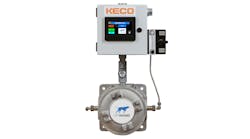This Control Talk column appeared in the February 2020 print edition of Control. To read more Control Talk columns click here or read the Control Talk blog here.
Greg: Inline measurement of the particle size distribution of crystals, particles and/or droplets can be used to provide more intelligent process operations including closed loop process control to improve process efficiency and capacity, and product quality in multiphase systems. Knowing the size and respective concentration is important in many processes (e.g., centrifugation, crystallization, drying, emulsification, filtration, flocculation, precipitation) to improve process parameters and ensure optimal down-stream process performance. Dr. Ulrich Schacht, Mettler Toledo Market Development Manager, can tell us how we can have a successful application of inline measurement of particles by use of the Focused Beam Reflectance (FRBM) probe and analyzer.
Ulrich, what is the basic principle of operation?
Ulrich: A probe-based analyzer is inserted directly into a vessel or pipeline to measure particle size distribution in-situ and in real time without dilution and at full process concentration. A rotating laser determines particle size and counts the number of particles detected. Size and count information are combined, giving the number based on particle size distribution. This size distribution is a dynamic fingerprint of the process and particle population that changes as the process is changing. Key particle statistics like the number of particles in individual size classes with mean or median particle size evolution trended over time for detailed data analysis.
Greg: What are some key applications?
Ulrich: ParticleTrack with FBRM technology is very broadly applicable in most particle or droplet processes across many industries (pharma, chemical, oil & gas, and food). One key application is process development, where ParticleTrack follows and visualizes how different process parameters (stirring, cooling or dosing rates) influence the final product quality. Understanding these relationships allows scientists to design the optimal particle process quickly.
Another key application is monitoring and control of large-scale manufacturing processes to ensure consistent product quality. Changes in raw material sources, vessel geometries, stirrer dimensions or other processing equipment can dramatically impact process performance and cause out-of-specification product. Detecting process upset in-situ and in real time enables operators to take corrective actions immediately, and minimizes product loss, expensive rework or disposal.
Greg: What are some watch-outs as to things that can go wrong?
Ulrich: It is important to ensure that the hydrodynamics bring particles and droplets in contact with the probe window, where the size and count measurement happens.
In the past, scientists and operators had to take samples to bring particles to the offline analytical instrument for analysis. ParticleTrack is inserted directly into the process and it is important that the hydrodynamics bring the particles to the probe window for analysis.
If the probe is facing away from the particle or droplet stream, it will not be able to measure the particle size robustly and repeatedly. However, METTLER TOLEDO helps and supports with identifying ideal probe locations to ensure high quality and resilient data.
Greg: What are some installation and maintenance suggestions?
Ulrich: There is a very wide variety of installation options for any vessel or pipeline. In the laboratory, METTLER TOLEDO offers adapters for all common glass reactor lids and special compression fittings for pipeline installations. For pilot plant setups, flange adapter or tri-clamp adapter are available, and at plant scale, mostly flange adapter and dip-pipe installations are being used. All these installation options are standard parts and can be obtained quickly through METTLER TOLEDO.
In terms of maintenance, it is recommended to give a ParticleTrack the same love and care as our personal car. To ensure maximum uptime and to always be fully operational, it is strongly recommended to have a ParticleTrack serviced annually or to make use of a preventative maintenance service contract. Both service options protect the investment, minimize downtime and make for happy users.
Greg: What is the suggested frequency and methods for calibration?
Ulrich: ParticleTrack with FBRM technology is a calibration-free analytical method. However, it is recommended to verify the validation once per quarter. Every ParticleTrack comes with a special PVC suspension sample of known particle size and reference distribution. The PVC validation procedure takes about 5 min and immediately indicates if the ParticleTrack operates within specification.
Should the measurement unexpectedly be out of specification, a qualified METTLER TOLEDO Service Engineer can adjust the instrument to bring it back into specification.
Greg: What affects measurement performance?
Ulrich: There are no fixed limits on the viscosity, density or concentration of suspended material that can be measured with FBRM. However, measurement with FBRM requires a representative sample of the process material to flow across the window of the probe. There may be limits on the ability of given processing equipment to effectively mix or transport a slurry or emulsion which must be taken into consideration, especially in a process stream with high viscosity or high solids concentration.
Flow speed of the particles past the probe window will have an effect on the measurement, as the FBRM measurement is based on an assumption that the particles are moving much slower than the scan speed of the probe. The FBRM focused beam is typically scanning at 2 m/s on a standard instrument, and the effect of particle flow speed can often be ignored for flow speeds less than 1 m/s. If higher flow speeds are present, pneumatic probe models (G600 and G600 Ex), can operate at higher scan speeds to reduce the effect of flow.
For the purpose of monitoring particulate systems for optimization and control, measurement precision is much more important than accuracy. Unlike many simpler point measurements, the accuracy of particle size analyzers is extremely difficult to define for complex multiphase systems or for non-spherical particles which cannot be defined by a single characteristic dimension.
For a given particle system, measurement precision will be a function of the size distribution and the particle concentration. As the concentration and particle count increase, the measurement precision will improve. With a 10-second sampling interval, for example, a measurement repeatability of 3% or less can typically be achieved for particle concentrations ranging from 0.1% by volume and above.
The precision of the FBRM measurement can be further improved by increasing the sampling rate or the use of a data filter such as a moving average.
The FBRM measurement provides the capability to measure and count chord lengths between 0.5 and 2000 microns. Typical operation often uses a default displayed Chord Length Distribution (CLD) of 1 to 1000 microns. Sensitivity is impacted by the optical properties of the particles and the carrying fluid. Optically transparent materials or extremely smooth surfaces may not backscatter effectively and may not be suitable for FBRM measurement.
Sensitivity of the FBRM measurement is typically determined by its ability to measure CLD statistics such as particle count in a specified range that has been correlated to a known product quality attribute or downstream process efficiency measurement.
You do not really need to worry about all these boundary conditions like very high viscosities, maximum sold concentration, particle velocities or the optimal measurement interval. If you would like to measure particle size in-situ without the need for sampling and often erroneous offline analysis, please get in touch with METTLER TOLEDO AutoChem.
The easiest way to reach METTLER TOLEDO AutoChem is via phone or the internet. Our website www.mt.com/AutoChem contains a lot of useful information, application examples and other in-situ technologies, for example, in-situ Raman, in-situ IR, in-situ microscopy and many more.
Once we hear from you, an experienced Technology and Application Consultant (TAC) will agree to a visit to perform an Application Feasibility Test (AFT) on exactly the system you are interested in. TACs do not bring or measure generic sample systems, they always measure the real customer system in order to prove that ParticleTrack can be used successfully measure and optimize your system. If ParticleTrack cannot measure your system, then that is also an important learning outcome from an AFT and we understand why that is.
Greg: For much more on what to know about this opportunity see “Section 3.6 Focused Beam Reflectance Measurement” in the McGraw-Hill Process/Industrial Instruments and Controls Handbook Sixth Edition 2019 and the feature article “Improve Products and Processes with Inline Particle Analysis” in Chemical Engineering Progress, August 2017.
The following best practices from the McGraw-Hill handbook are offered:
- Develop a Standard Operating Procedure (SOP) that steps users through software operation required to ensure consistent data collection. A pre-designed template is recommended to simplify startup by defining the measurement configuration (measurement interval and averaging) and the appropriate statistics of interest that can directly track particle and product quality parameters of interest.
- Check and ensure probe window cleanliness as part of routine SOP.
- Schedule and follow recommended calibration validation procedures monthly or quarterly as determined by your SOP.
- To ensure maximum sensitivity, locate the probe with the tip positioned so that the sapphire window is fully submerged in the process fluid in a well-mixed region of the process where a representative sample of the particles of interest will flow past the probe.
- Install probe at a 30 to 60-degree angle against the direction of flow.
- For pipes, install probe at a 45-degree angle 3-5 pipe diameters following a bend or pump in a vertical section of pipe with flow in an upward direction.
- For pipes, locate the tip of the probe near the centerline of the pipe if practical given pipe size and fluid viscosity. The probe tip must be installed so that the entire probe window is within a well-mixed region of the process fluid beyond any possible boundary layer or stratification.
10. “Look for helpers for process control improvement. There are always engineers and technicians who will gladly offer technical support in the project team and in maintenance and operations.”
9. “If you could only sense how important you are, there would be automation opportunities you may never have dreamed of.”
8. “There is something of yourself that you leave with every system you design and PID and positioner that you tune.”
7. “It is not so much what we have in IT that matters. It is what we do with what we already have with smart instruments and powerful controllers.”
6. “Automation engineers need a sense of worth, and it will be achieved only by people feeling the improvement by automation is worthwhile.”
5. “We are in a plant in which we need to share responsibility for process performance. There are those who see the need and respond. I consider them my heroes.”
4. “Often when you think you’re at the end of something, you’re at the beginning of something else like process control improvement.”
3. “There is no normal life that is free of pain. It’s the very wrestling with our problems that can be the impetus for our growth. We learn the most from mistakes.”
2. “Imagine what our plant would be like if everyone offered, as a matter of course, just one kind word to an automation engineer.”
1. “Let’s raise a glass to those who choose to see the plant in which nothing can stop them from achieving greatness in process performance.”






